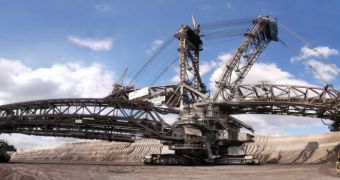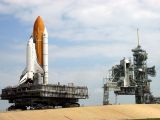The title of the largest tracked vehicle in the world currently belongs to the Bagger 288, a bucket-wheel excavator, which was constructed by the German company Krupp for the purpose of stripping entire mountains bare and reaching even the deepest coal reserves. At 13,500 tons, it's currently the world's largest vehicle, and is seconded by NASA's Crawler-transporter, a machine designed to carry rockets and space shuttles from the Vehicle Assembly Building (VAB), along the Crawlerway, to Launch Complex 39.
The Bagger 288 is the most impressive massive excavator in the world, and a wonder to look at. When deployed in specific layouts, it cannot be seen all at once, if too close by. Its front end is endowed with 18 mining buckets able to hold about 6.6 cubic meters, or 7.9 cubic yards, of overburden. In all, its head has a diameter of 21.6 meters, which makes it larger than a four-story building. To support this massive operating device, the body was constructed to a length of 240 meters (787 feet) and it's also approximately 96-meter (314 foot) high. Undoubtedly, this is one of the most massive and impressive constructions ever made by man.
To move this colossus, its central section is placed on 3 rows of 4 caterpillar track assemblies, each roughly 3.8-meter (12.5-foot) wide, which means that the machine can easily turn around within a radius of 100 meters, which is very little for an excavator its size. Also, the large tracked portion of the vehicle allows it to move relatively fast on the ground, as even at 13,500 tons it doesn't leave a very large impression on the soil. It moves best on gravel and rocks, although it can navigate on grass as well, at a speed of roughly 250-300 meters (820-990 feet) per hour.
The construction and assembly of the Bagger 288, which took 10 years to complete, meant that NASA's Crawler-transporter became the world's second-largest tracked vehicle. It was built by the Marion Power Shovel Company, following a design submitted by Bucyrus International, and was used to transport the Saturn V and the Saturn IB rockets, as well as the Apollo-Soyuz Test Project and the space shuttles, from the Kennedy Space Center (KSC)'s VAB to one of the two launching pads.
As opposed to the Bagger 288, this vehicle is only 131 feet (40 meters) by 114 feet (35 meters), but has the advantage of being self-powered. Through the excavator, 16.56 megawatts of externally-supplied electrical current are required in order for it to work. The Crawler is able to supply this energy all by itself. It moves on 8 sets of tracks, two on each corner, and, when unloaded, can circulate with speeds of up to 2 miles per hour. When carrying a cargo, it only travels at 1 mile per hour.
Since 1965, the two Crawlers that NASA and the KSC currently own have traveled more than 2,500 miles (4,000 km), carrying all the important missions that took off from this base. The American space agency announced that it planned to modify one of the vehicles in such a way that it would be able to carry the ARES I and ARES V rockets as well, and that the other would continue to be used for further routine launches.

 14 DAY TRIAL //
14 DAY TRIAL // 
